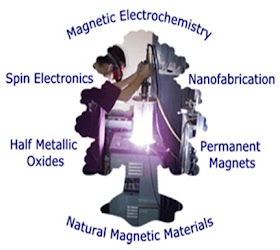Spintronics is a technology that
utilizes nano magnets’ spin direction as the state variable. Spintronics has
unique properties over CMOS, including nonvolatility, lower device count, and
the potential for non-Boolean computing architectures. Spintronics devices’
nonvolatility enables instant processor wake-up and power-down that could
dramatically reduce the static power consumption. Furthermore, it can enable
novel processor-in-memory or logic-in-memory architectures that are not
possible with silicon technology. Although in its infancy, research in
spintronics has been gaining momentum over the past decade, as these devices
could potentially overcome the power bottleneck of CMOS scaling by offering a
completely new computing paradigm.
 |
| Power Etching Process for Spin Electronics Devices |
In recent years, progress has been made
toward demonstration of various post-CMOS spintronic devices including all-spin
logic, spin wave devices, domain wall magnets for logic applications, and spin
transfer torque magnetoresistive RAM (STT-MRAM) and spin-Hall torque (SHT) MRAM
for memory applications. However, for spintronics technology to become a viable
post-CMOS device platform, researchers must find ways to eliminate the
transistors required to drive the clock and power supply signals. Otherwise,
the performance will always be limited by CMOS technology. Other remaining
challenges for spintronics devices include their relatively high active power;
short interconnect distance, and complex fabrication process.
 |
| Electronics research focuses on magnetic materials |
Author - Akash Kumar
(Design Engineer at Silicon Mentor)

No comments:
Post a Comment